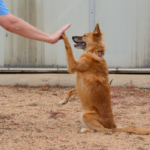Introduction
Embarking on journeys with your furry friend can be a transformative experience, but finding dog-friendly destinations can be challenging. This article aims to be your guide to dog-friendly travel, offering insights into the best destinations, potential challenges, and practical solutions for a seamless adventure with your canine companion.
Unleashing the Best Dog-Friendly Spots
In the realm of canine companionship, discovering destinations that warmly embrace dogs adds an extra layer of joy to travel experiences. From pristine parks and sandy beaches to vibrant cities, there are enchanting locales that cater to both human wanderlust and canine enthusiasm.
Parks and Natural Retreats: Nature-loving dog owners will delight in the abundance of dog-friendly parks around the world. These green havens often boast open spaces, walking trails, and sometimes even designated off-leash areas for dogs to frolic freely. Whether it’s a vast national park or a local green space, the key is to choose destinations that prioritize the well-being of our four-legged friends.
Seaside Bliss: For water-loving pups and their owners, dog-friendly beaches are a haven of excitement. These sandy stretches provide ample space for dogs to run, play, and, of course, take a refreshing dip. Explore the coastal charms of destinations that not only tolerate dogs on their shores but actively welcome them, recognizing the unique joy they bring to the beach experience.
Cityscapes with a Canine Touch: Urban adventures need not exclude our furry companions. Many cities are evolving to embrace a pet-friendly atmosphere, with welcoming parks, dog-friendly cafes, and accommodation options that cater to both human and canine needs. Highlighting such cities allows dog owners to plan trips that seamlessly integrate the joy of urban exploration with the companionship of their pets.
Factors Contributing to a Positive Experience: In discussing these dog-friendly spots, it’s crucial to delve into the factors that contribute to a positive travel experience for dogs. This includes understanding local regulations, ensuring open spaces for exercise, and selecting accommodations that not only permit dogs but also prioritize their comfort.
Navigating Accommodations with Fido
Embarking on a journey with your furry companion often involves navigating the landscape of pet-friendly accommodations. From hotels to vacation rentals and campgrounds, finding the perfect stay for you and your canine friend can be an enriching experience with a bit of planning and awareness.
1. Hotels: Many hotels now recognize the importance of catering to pet owners, offering dog-friendly rooms and amenities. However, challenges may arise, such as limited availability or specific restrictions on dog size and breed. To overcome these issues, consider researching and booking well in advance. Look for hotels with spacious grounds, nearby parks, or designated dog-walking areas to ensure your pet’s comfort.
2. Vacation Rentals: Opting for a vacation rental provides the advantage of a more home-like environment for your dog. However, not all rentals are pet-friendly, and some may have restrictions or additional fees. Prioritize properties with pet-friendly policies, ample indoor and outdoor space, and proximity to pet-friendly attractions. Clearly communicate your pet’s needs with the host to ensure a smooth and enjoyable stay.
3. Campgrounds: For those seeking a more outdoorsy adventure, campgrounds can be an ideal choice. Many campgrounds welcome four-legged campers, but it’s crucial to understand their pet policies. Some may have leash requirements, designated dog-friendly areas, or restrictions on the number of pets allowed. Researching pet-friendly campgrounds and their amenities ensures a harmonious camping experience for both you and your dog.
Navigating Challenges: Common challenges include limited pet-friendly options, breed restrictions, or unexpected fees. Combat these by planning ahead, reading reviews from pet owners who have stayed at the accommodation, and contacting the establishment directly to clarify their policies. This proactive approach enhances the likelihood of securing accommodations that prioritize your and your pet’s comfort.
Canine Cuisine on the Road
Embarking on a journey with your canine companion doesn’t mean compromising on their dining experience. Exploring canine cuisine on the road involves discovering pet-friendly eateries and addressing potential dietary concerns to ensure a delightful dining adventure for both you and your furry friend.
1. Pet-Friendly Restaurants and Cafes: Researching and choosing pet-friendly establishments is the key to a positive dining experience with your dog. Many restaurants and cafes now welcome furry patrons, offering outdoor seating or designated pet-friendly areas. Before heading out, check online platforms or pet-friendly directories to find suitable options along your route.
2. Addressing Dietary Concerns: Dogs, like humans, have specific dietary needs. To address potential concerns on the road, consider packing a supply of your dog’s regular food to maintain consistency in their diet. This helps prevent digestive issues and ensures they receive the nutrients they need. Additionally, be mindful of any food allergies or sensitivities your dog may have when exploring new dining options.
3. Dog-Friendly Snacks: While indulging in a meal, it’s essential to have dog-friendly snacks on hand. Pack treats or snacks that are easy to carry, non-perishable, and well-loved by your dog. These treats can serve as rewards during the journey or a comforting distraction if they get anxious in new environments.
4. Outdoor Seating: When selecting places to dine, opt for establishments with outdoor seating options. This allows your dog to join you in a comfortable and open space, reducing potential stress or discomfort. Additionally, outdoor areas provide a more relaxed atmosphere, allowing both you and your pup to enjoy the surroundings.
Transportation Tailored for Dogs
Embarking on a journey with your canine companion requires careful consideration of transportation methods to ensure a safe and stress-free experience. Whether traveling by car, plane, or public transport, navigating the challenges associated with transporting your dog involves addressing safety concerns, logistical planning, and implementing strategies for a smooth journey.
1. Car Travel: When traveling by car, safety is paramount. Invest in a secure and comfortable pet restraint system, such as a harness or a travel crate, to prevent injury in case of sudden stops. Familiarize your dog with short drives before embarking on a longer journey, and make frequent stops for bathroom breaks, exercise, and hydration. Ensure proper ventilation inside the vehicle, and never leave your dog unattended in a parked car, especially in warm weather.
2. Air Travel: If flying with your dog, research airline pet policies and choose carriers that prioritize pet safety and well-being. Acquaint your dog with their travel crate beforehand, making it a familiar and comfortable space. Consult your veterinarian for guidance on sedation or anxiety management if needed. Ensure all required documentation, including health certificates and vaccination records, is in order well before the travel date.
3. Public Transport: Using public transportation may present unique challenges. Check the pet policies of buses, trains, or subways to ensure compliance with regulations. For small dogs, a well-ventilated carrier or bag is often necessary. Larger dogs may require a muzzle and a secure leash. Plan your route, considering quieter travel times to minimize stress for your dog, and be mindful of fellow passengers.
Exploring Adventure Activities
Embarking on adventure activities with your canine companion adds an extra layer of joy to your outdoor experiences. From hiking trails and outdoor excursions to pet-friendly tours and events, there are countless opportunities to create lasting memories with your furry friend. However, navigating through potential challenges and ensuring a positive adventure for both you and your dog requires thoughtful planning.
1. Hiking Trails: Many dogs relish the opportunity to explore nature on hiking trails. Before heading out, research and choose trails that are dog-friendly and considerate of your dog’s fitness level. Bring essentials like water, collapsible bowls, and a first aid kit. Check local regulations, as some trails may require dogs to be leashed for safety and environmental reasons.
2. Outdoor Excursions: Dogs thrive in wide-open spaces. Plan outdoor excursions such as beach outings, picnics, or visits to dog-friendly parks. Ensure that the chosen location allows dogs and provides a secure environment. Engage in interactive play, such as fetch or frisbee, to keep your dog active and entertained.
3. Pet-Friendly Tours: Explore the growing trend of pet-friendly tours that cater to both human and canine interests. From walking tours of historical sites to dog-friendly boat excursions, these experiences offer a unique way to bond with your dog while enjoying local attractions. Verify the tour’s pet policy and any specific requirements beforehand.
4. Dog-Friendly Events: Attend dog-friendly events, such as pet expos, canine festivals, or charity walks. These gatherings not only provide socialization opportunities for your dog but also connect you with like-minded pet owners. Be mindful of your dog’s comfort and energy levels in bustling environments.
Conclusion
Wanderlust with your woof is a journey worth embracing. By exploring dog-friendly travel destinations and implementing practical solutions, you can turn your travels into unforgettable experiences for you and your furry friend. Happy trails!







